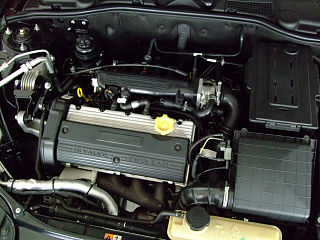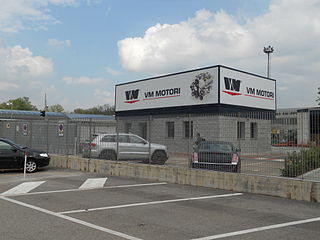Related Research Articles

MG is a British automotive marque founded by Cecil Kimber in the 1920s, and M.G. Car Company Limited was the British sports car manufacturer that made the marque famous. Best known for its open two-seater sports cars, MG also produced saloons and coupés, with engines up to three litres in size and 3.5L in the case of the MGB GT V8. The marque is now owned by Chinese state-owned automaker SAIC Motor Corporation Limited.

The straight-six engine is a piston engine with six cylinders arranged in a straight line along the crankshaft. A straight-six engine has perfect primary and secondary engine balance, resulting in fewer vibrations than other designs of six or less cylinders.

MG Rover Group was the last domestically owned mass-production car manufacturer in the British motor industry. The company was formed when BMW sold the car-making and engine manufacturing assets of the original Rover Group to the Phoenix Consortium in 2000.

The Rover Group plc was the British vehicle manufacturing conglomerate known as "BL plc" until 1986, which had been a state-owned company since 1975. It initially included the Austin Rover Group car business, Land Rover Group, Freight Rover vans and Leyland Trucks. The Rover Group also owned the dormant trademarks from the many companies that had merged into British Leyland and its predecessors such as Triumph, Morris, Wolseley, Riley and Alvis.

The Metro is a supermini car, later a city car that was produced by British Leyland (BL) and, later, the Rover Group from 1980 to 1998. It was launched in 1980 as the Austin mini Metro. It was intended to complement and eventually replace the Mini, and was developed under the codename LC8. The Metro was named by What Car? magazine as 'Car of The Year' in 1983 as an MG, and again as the Rover Metro in 1991.

The Rover K-series engine is a series of internal combustion engines built by Powertrain Ltd, a sister company of MG Rover. The engine was a straight-four cylinder built in two forms, SOHC and DOHC, ranging from 1.1 to 1.8 L; 67.9 to 109.6 cu in.

The Rover 800 series is an executive car range manufactured by the Austin Rover Group subsidiary of British Leyland, and its successor the Rover Group from 1986 to 1999. It was also marketed as the Sterling in the United States. Co-developed with Honda, it was a close relative to the Honda Legend and the successor to the decade-old Rover SD1.
The GM Ecotec engine, also known by its codename L850, is a family of all-aluminium inline-four engines, displacing between 1.4 and 2.5 litres. While these engines were based on the GM Family II engine, the architecture was substantially re-engineered for the new Ecotec application produced since 2000. This engine family replaced the GM Family II engine, the GM 122 engine, the Saab H engine, and the Quad 4 engine. It is manufactured in multiple locations, to include Spring Hill Manufacturing, in Spring Hill, Tennessee while the engine block and cylinder heads are cast at Saginaw Metal Casting Operations in Saginaw, Michigan.

The Rover 400 Series, and later the Rover 45, are a series of small family cars that were produced by the British manufacturer Rover from 1990 to 2005. The cars were co-developed as part of Rover's collaboration with Honda. The first-generation 400 was based on the Honda Concerto, and the Mark II 400 was based on the Honda Domani/Civic.

VM Motori S.p.A. is an Italian diesel engine manufacturing company which is wholly owned by Stellantis. VM headquarters and main production facilities are located in Cento, in Emilia-Romagna, Italy.

The Austin Motor Company A series is a small straight-4 automobile engine. Launched in 1951 with the Austin A30, production lasted until 2000 in the Mini. It used a cast-iron block and cylinder head, and a steel crankshaft with 3 main bearings. The camshaft ran in the cylinder block, driven by a single-row chain for most applications, and with tappets sliding in the block, accessible through pressed steel side covers for most applications, and with overhead valves operated through rockers. The cylinder blocks are not interchangeable between versions intended for conventional end-on mounted gearboxes and the 'in-sump' transaxle used on BMC/BL front wheel drive models such as the Mini. The cylinder head for the overhead-valve version of the A-series engine was designed by Harry Weslake – a cylinder head specialist famed for his involvement in SS (Jaguar) engines and several F1-title winning engines. Although a "clean sheet" design, the A series owed much to established Austin engine design practise, resembling in general design and overall appearance a scaled-down version of the 1200cc overhead-valve engine first seen in the Austin A40 Devon which would form the basis of the later B-series engine.

The BMC B series was a line of straight-4 & straight-6 internal combustion engine mostly used in motor cars, created by British automotive manufacturer Austin Motor Company.
Multijet is Fiat Chrysler Automobiles' term for its current common rail direct injection turbodiesel engine range. Most of the Fiat, Alfa Romeo, Lancia range as well as certain Chrysler, RAM Trucks, Jeep and Maserati vehicles are equipped with Multijet engines. Ownership of some Fiat Multijet designs is shared with General Motors as part of a settlement of the failed merger between the two auto conglomerates. GM Powertrain Torino group in Turin, Italy manages their interest in these engines. Some PSA Peugeot Citroën diesel engines are also rebadged JTD units, and vice versa. Fiat's common rail diesel engine is also known as JTD, an initialism of Jet Turbo Diesel.

The Isuzu Panther is a line of multi-purpose vehicle and pickup truck manufactured by Isuzu from 1991 until 2020 and developed in Indonesia for the Southeast Asian market. The second generation Panther was also manufactured and marketed in India under the name Chevrolet Tavera, a name which is also used in Indonesia for the petrol version until 2005. It was developed together with General Motors as the "160 Project".

The KV6 automotive petrol engine has a 24-valve quad-cam V6 configuration, and a pressurising variable-length intake manifold to add hot spots throughout the rev range. Variants exist in 2.0 to 2.5 litres capacities. These were built initially by Rover Group, then by Powertrain Ltd. KIA manufactured KV6 in Korea under licence. Production moved from the UK to China in 2005, re-designated NV6.

The BL O-series engine is a straight-4 automobile engine family that was produced by the Austin-Morris division of British Leyland (BL) as a development of the BMC B-series engine family.
The L-series engine is an automotive diesel engine built by Powertrain Ltd, a sister company of MG Rover.
Powertrain Ltd was a British company based in Birmingham which made some cars, manufactured and marketed car engines and transmissions. The company was owned by MG Rover Group and Phoenix Venture Holdings and was based in the South Works at Rover's Longbridge plant. The companies main products were the K-Series four-cylinder and six-cylinder Engines and the L-Series four-cylinder diesel engine. The company mainly produced engines for MG Rover between 2000 and 2005 but also supplied Land Rover with the L-Series and K-Series engines for the Land Rover Freelander which was developed by Rover Group in the 1990s during the ownership by BMW and British Aerospace. As well as Land Rover, K-Series engines were also supplied to many small mass production car companies like MG Rover such as FSO and SAPIA.
The Austin D and K series engines are a straight-six engine made by the British Austin Motor Company between 1939 and 1968. It was developed initially for the lorry market; but was used in a number of automobiles in its later life. It was an overhead valve non-crossflow cylinder head design. Both block and head were made out of cast iron. All engines had a forged four main bearing crankshaft.
References
- ↑ Adams, Keith (28 August 2011). "Engines : Powertrain 2000–2005". Austin-Rover Online. Retrieved 16 February 2017.
- ↑ Adams, Keith (28 August 2011). "Engines : Powertrain 2000-2005". Austin-Rover Online. Retrieved 16 February 2017.
- 1 2 "Chevrolet Tavera Neo 3 review, test drive". Autocar India. Retrieved 16 February 2017.
- ↑ "New ICML Extreme". MotorTrend India. Retrieved 16 February 2017.
- ↑ Singh, Siddhraj. "Born tough". The Hindu. Retrieved 17 February 2017.
- ↑ "Chevrolet Tavera Neo 3 review, test drive". Hindustan Times. 16 November 2012. Retrieved 16 February 2017.
- ↑ Adams, Keith (28 August 2011). "Engines : Powertrain 2000-2005". Austin-Rover Online. Retrieved 16 February 2017.
- ↑ Adams, Keith (28 August 2011). "Engines : Powertrain 2000–2005". Austin-Rover Online. Retrieved 16 February 2017.
- ↑ Adams, Keith (28 August 2011). "Engines : Powertrain 2000–2005". Austin-Rover Online. Retrieved 16 February 2017.
- ↑ Adams, Keith (28 August 2011). "Engines : Powertrain 2000-2005". Austin-Rover Online. Retrieved 16 February 2017.
- ↑ Adams, Keith (28 August 2011). "Engines : Powertrain 2000-2005". Austin-Rover Online. Retrieved 16 February 2017.
- ↑ "A World Of Difference". Diesel Car. Retrieved 16 February 2017.
- ↑ "Engines : Powertrain 2000-2005". Austin-Rover Online. 28 August 2011. Retrieved 16 February 2017.
- ↑ Nagrani, Rohin. "Sonakila Rhino RX". BS Motoring. Retrieved 16 February 2017.
- 1 2 3 4 "ICML Extreme LD". ICML. Retrieved 16 February 2017.
- ↑ "ICML Extreme LD". ICML. Retrieved 16 February 2017.
- ↑ "New ICML Extreme". MotorTrend India. Retrieved 17 February 2017.
- ↑ "ICML Rhino RX CRDFI BS-IV Specifications". India.com. Retrieved 20 October 2017.
- ↑ "ICML launch Extreme SUV at Rs 5.88 lakh". Goa on Wheels. Retrieved 17 February 2017.